Salabhasana

This asana is part of the key movements in rearward bending movements. As its name denotes, this movement is similar to that of a "locust to a great extent" and is performed in three levels, preparatory, mediocre and advanced.
Benefits:
- It activates the Para sympathetic and creates tranquility
- Reduces sciatic pains
- Leads to eliminating digestive problems
- Improves disintegration of the bladder
- Reduces abdominal fat
- Regulates the adrenal glands.
Restrictions:
- Persons suffering from hypertension
- Severe problems in the lumbar region
- Cardiac conditions/diseases
- Abdominal surgery of less than six months
- Hernia discomforts
- Intense Myopia
Muscles active in the Salabhasana movements:
- The large gluteus maximus muscle rotates the hip joint and assists to lower the pelvic
- The hamstring muscle raises the knees
- Adductors: The adductor magnus of the thighs draws the thighs closer together, pulls out the hip joint and brings the knees towards each other
- The Quadriceps Muscle
- The gluteus maximus assists to straighten out the knees
- The spine erector: Creates a curve in the vertebrae
- The lower trapezius muscles lowers the shoulders
- The triceps straightens the elbows
- The minor and major pectoralis expands the rib cage (chest cavity) and draws it forward
Two groups of muscles are strengthened in the Shalabhasana (movements):
- A. Surface muscles which comprise of the muscles of the calves (gastrocnemiu), hamstring, gluteuses and the broad latimus dorsi muscle the rhomboids and trapezius muscles.
- B. The profound muscles, which comprise of the multifidis muscle, the ilicostal lumborum muscle and the longissimus thoracis muscle.
The observance of helpful features for a better performance of Salabhasana:
- In Salabhasana, where the legs are on the ground, in order to raise the chest cavity better, the legs must be pressed towards the floor. This action activates the muscles of the legs and the knees take a slight distance from the ground and the chest is raised in a better way in this mode.
- By utilizing a blanket folded into four, under the tail end of the cavea thoracis can raise and draw the chest forward, including the fortifying of the back muscles.
- In Salabhasana, where the legs are at a distance from the ground, the upper torso of the body should be lifted, with legs straight till the entire muscle of the legs contract and this contraction is sensed till the tips of the toes; with stretching the toes the muscles of the calves and soles get activated.
Super advanced Salabhasana:
Adhere to the Salabhasana position and place the palms, in a fisted fashion, under the thighs.
The chin is on the floor. Contract the pelvic and knee muscles and insert pressure on the ground from the end of the pelvic, keeping the legs straight and stretched out. Together with exhalation, the legs should be lifted from the pelvic region, taking it as high as possible.
In this condition, the sides of the knees and heels should be stretched together and the muscles on the legs should be stretched to the maximum and this position should be maintained for 10 to 15 seconds, returning to the initial stage, relax or release all the muscles so that the prostration of the waist can be performed.
